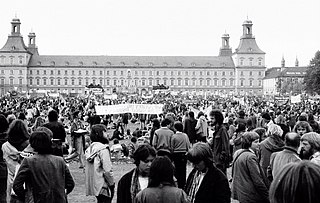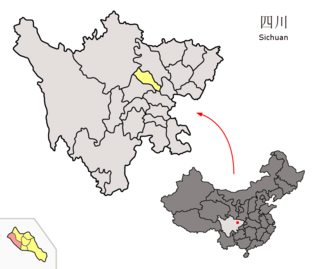
The Asahi Shimbun is one of the four largest newspapers in Japan. Founded in 1879, it is also one of the oldest newspapers in Japan and Asia, and is considered a newspaper of record for Japan. Its circulation, which was 4.57 million for its morning edition and 1.33 million for its evening edition as of July 2021, was second behind that of the Yomiuri Shimbun. By print circulation, it is the third largest newspaper in the world behind the Yomiuri, though its digital size trails that of many global newspapers including The New York Times.

Nantong is a prefecture-level city in southeastern Jiangsu province, China. Located on the northern bank of the Yangtze River, near the river mouth. Nantong is a vital river port bordering Yancheng to the north; Taizhou to the west; Suzhou, Wuxi and Shanghai to the south across the river; and the East China Sea to the east. Its population was 7,726,635 as of the 2020 census, 3,766,534 of whom lived in the built-up area made up of three urban districts.

Qidong is a county-level city under the administration of the prefecture-level city of Nantong in southeastern Jiangsu province, China. It is located on the north side of the Yangtze River opposite Shanghai and forms a peninsula jutting out into the East China Sea. It has a population of 1.12 million.

The anti-nuclear movement is a social movement that opposes various nuclear technologies. Some direct action groups, environmental movements, and professional organisations have identified themselves with the movement at the local, national, or international level. Major anti-nuclear groups include Campaign for Nuclear Disarmament, Friends of the Earth, Greenpeace, International Physicians for the Prevention of Nuclear War, Peace Action, Seneca Women's Encampment for a Future of Peace and Justice and the Nuclear Information and Resource Service. The initial objective of the movement was nuclear disarmament, though since the late 1960s opposition has included the use of nuclear power. Many anti-nuclear groups oppose both nuclear power and nuclear weapons. The formation of green parties in the 1970s and 1980s was often a direct result of anti-nuclear politics.

Haimen is a district of Nantong, Jiangsu province, with a population of approximately 1 million. It is located at the opposite side of the Yangtze River to Shanghai and is directly north of Chongming Island except for a small portion that forms Haimen District's Haiyong Town. Haimen is the seat of the Roman Catholic Diocese of Haimen. Haimen is located in the poorer north Jiangsu region and together with Qidong City, traditionally has one of the highest rates of liver cancer in China and in the world, with upwards of 1 out of every 10 adults in the rural areas dying from liver cancer.
Anti-environmentalism is a movement that favors loose environmental regulation in favor of economic benefits and opposes strict environmental regulation aimed at preserving nature and the planet. Anti-environmentalists seek to persuade the public that environmental policy impacts society negatively. The movement's goals include to counter the effects of environmental ideology and movements, to diminish public concern about the environment and to persuade politicians against increasing environmental regulations.

Environmental issues in China had risen in tandem with the country's rapid industrialisation, as well as lax environmental oversight especially during the early 2000s. China was ranked 120th out of the 180 countries on the 2020 Environmental Performance Index.
Environmental policy in China is set by the National People's Congress and managed by the Ministry of Environmental Protection of the People's Republic of China. Under the Ministry of Environmental Protection of the People's Republic of China, the Department of Policies, Laws, and Regulations is in charge of establishing and strengthening basic laws and policies such as environmental laws, administrative policies and economical regulations. It is also responsible for the development of national environmental protection policy and macro strategy.
Nuclear power in Taiwan accounts for 2,945 MWe of capacity by means of 2 active plants and 3 reactors. In 2015, before the closure of 3 reactors, they made up around 8.1% of its national primary energy consumption, and 19% of its electricity generation. The technology chosen for the reactors has been General Electric BWR technology for 2 plants and Westinghouse PWR technology for the Maanshan Nuclear Power Plant. Construction of the Lungmen Nuclear Power Plant using the ABWR design has encountered public opposition and a host of delays, and in April 2014 the government decided to suspend construction.

Shifang is a county-level city in Sichuan, China, under administration of Deyang prefecture-level city. It is located directly about 50 kilometers (31 mi) from Chengdu. It had an area of 863 km2 (333 sq mi) and a population of 430,000 in 2004. Shifang has a history stretching back over two thousand years. It suffered heavy damage during the 2008 Sichuan earthquake. The city was also the scene of a large-scale environmental protest against a copper smelting plant in July 2012.

The Nanjing–Qidong railway, commonly referred to in short as the Ningqi railway, is a higher-speed rail line in Jiangsu Province, China. Its common name is derived from Ning, the one-character abbreviation for Nanjing and Qi, which refers to Qidong, a county-level city of Nantong.

National Printing Bureau (NPB) is a Japanese governmental agency in charge of the production of Japanese paper money, Japanese yen. It also produces various other products, such as postage stamps and the official governmental gazette.
This is a list of notable events relating to the environment in 2012. They relate to environmental law, conservation, environmentalism and environmental issues.
The Shifang protest was a large-scale environmental protest in the southwestern Chinese city of Shifang, Sichuan province, against a copper plant that residents feared posed environmental and public health risks. The protests spanned 1–3 July 2012, and drew thousands of participants. Police were dispatched to break up the demonstrations, and reportedly shot tear gas and stun grenades into the crowd. Chinese authorities said some protesters has stormed a government building and smashed vehicles. Images and video of the protest circulated on the microblogs and social networking websites throughout China, some showing the protesters—many of them students—badly beaten. The protests ended late on 3 July when the local government announced that it had terminated construction of the metals plant and released all but six protesters who had been taken into custody.

The China anti-Japanese demonstrations of 2012 or 2012 Anti-Japanese riots and civil unrest in China and Taiwan were a series of demonstrations held across more than 100 cities in mainland China, Hong Kong and Taiwan during August and September 2012.

Over the last five decades there have been various plans for the relocation of Marine Corps Air Station Futenma, a United States Marine Corps base located within the urban area of Ginowan City in Okinawa, Japan.
Qilong is a township of Qidong in eastern Jiangsu province. The land it occupies was formerly Yonglongsha, a separate island in the Yangtze River delta, but reclamation projects and natural deposition of sediment have joined it to Chongming Island, where it now forms a pene-enclave within Shanghai's Chongming County. Its population was 3436 at the time of the 2010 Chinese census. Qilong's name—literally "opening prosperity"—is a compound of contracted forms of its county and its former island.

The Dakota Access Pipeline Protests, also called by the hashtag #NoDAPL, began in April 2016 as a grassroots opposition to the construction of Energy Transfer Partners' Dakota Access Pipeline in the northern United States and ended on February 23, 2017 when National Guard and law enforcement officers evicted the last remaining protesters. The pipeline runs from the Bakken oil fields in western North Dakota to southern Illinois, crossing beneath the Missouri and Mississippi rivers, as well as under part of Lake Oahe near the Standing Rock Indian Reservation. Many members of the Standing Rock tribe and surrounding communities consider the pipeline to be a serious threat to the region's water. The construction also directly threatens ancient burial grounds and cultural sites of historic importance.

The China PX protest is a series of public demonstrations against the presence of para-xylene (PX) chemical factories in several Chinese cities, including Xiamen, Dalian, Ningbo, Kunming and Maoming among them.
The anti-incinerator movement in China refers to the series of environmental protests that have occurred in opposition to China's numerous planned and operating industrial waste incinerators. The construction of these waste-to-energy facilities, which has prompted the ensuing protest movement, operates as part of China's ongoing efforts to restructure its waste disposal system in regard to its status as the largest producer of municipal solid waste worldwide since 2004. Described by some as being a new type of NIMBY protest, the roots of the anti-incinerator movement can be traced back to the early 1990s, following the introduction of China's first generation of incinerator plants. The movement, however, began in earnest with the benchmark 2006 Liulitun protest taking place in Beijing.













